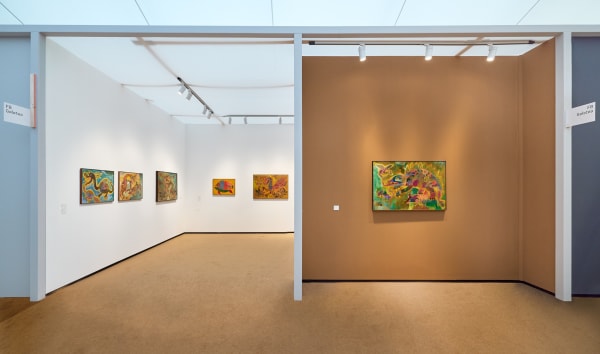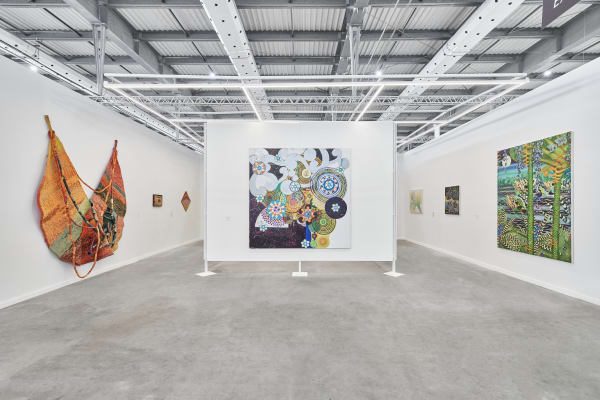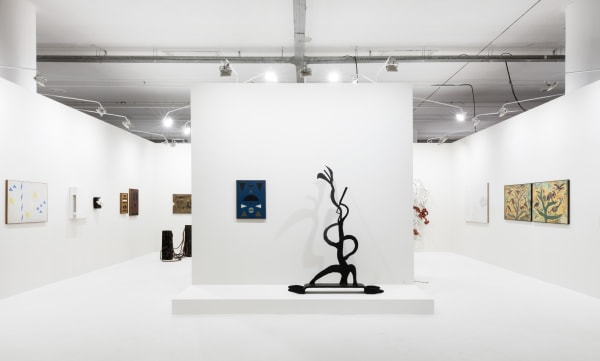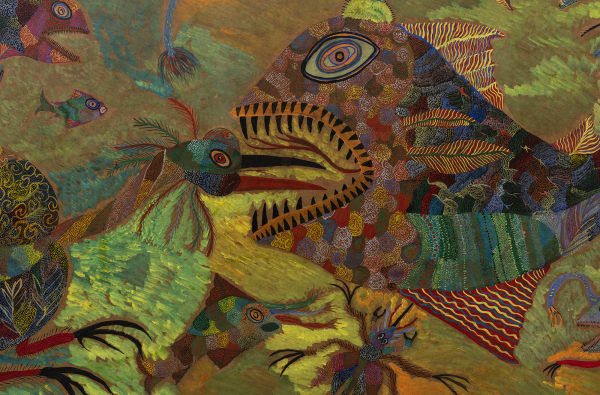Chico da Silva (Francisco Domingos da Silva) 1910-1985
Chico da Silva was born surrounded by the Amazon rainforest in Alto Tejo, but while still a child he moved to Ceará, in northeastern Brazil, passing through some countryside cities until he settled in Fortaleza in 1935, where he lived until his death. While painting the whitewashed walls of the fishermen’s houses in Praia Formosa, his artistic production began. Da Silva gave shape and color to his drawings with pieces of charcoal, bricks, leaves, and other elements found around him.
Jean-Pierre Chabloz (1910, Lausanne, Switzerland – 1985, Fortaleza, Ceará, Brazil), a Swiss critic and artist who moved to Brazil in 1940 because of World War II, traveled to Fortaleza for work in 1943, where he found da Silva’s drawings on a visit to the beach. This encounter had great relevance in the consolidation and dissemination of Chico da Silva’s work, opening doors for him to circulate in the main urban centers of Brazil, such as Rio de Janeiro and São Paulo, and throughout Europe, in cities such as Geneva, Neuchâtel, Lausanne, and Paris.
In his gouaches and paintings, Chico da Silva represented mainly the creatures of the forest, such as Amazon birds and fish, as well as fanciful figures, such as dragons. His artworks give form to stories and mythologies from the oral tradition of the culture of Northern Brazil, in compositions marked by rich polychromy and by the graphic details of the drawing, composed of colorful wefts and lines. Given the originality of his style and compositions, he stood out in the context of the so-called Brazilian popular art and, in addition to achieving great commercial success during his lifetime, he attracted considerable interest from critics.
Among the major exhibitions he has participated in are: Francisco da Silva, Galerie Pour L’Art, Lausanne, Switzerland, in 1950; Exposition d’Art Primitif et Moderne [Exhibition of Primitive and Modern Art], Musée d‘Ethnographie, Neuchâtel, Switzerland, in 1956; 8 Peintres Naïfs Brésiliens [8 Brazilian Naïve Painters], Galerie Jacques Massol, Paris, France, in 1965; 9ª São Paulo Art Biennial, Brazil, in 1967; Tradição e Ruptura: Síntese de Arte e Cultura Brasileiras [Tradition and Rupture: Synthesis of Brazilian Art and Culture], Fundação Bienal de São Paulo, Brazil, in 1984. In addition, in 1966 he received the Honorable Mention award for his participation in the 33rd Venice Biennale.
Currently, his works are part of numerous public collections, among them: Museo del Barrio, New York, USA; Museu de Arte Moderna do Rio de Janeiro - MAM, Brasil; Museu de Arte Contemporânea da Universidade de São Paulo – MAC USP, Brasil; and Musée International d'Art Naïf Anatole Jakovsky, Nice, France
-

Histórias da ecologia
Curated by: André Mesquita e Isabella Rjeille | MASP – SP 4 Sep 2025 - 1 Feb 2026Read more -

Alvaro Barrington & Chico da Silva
Mendes Wood DM – São Paulo 9 Nov 2024 - 28 Jan 2025Mendes Wood DM is pleased to present Alvaro Barrington & Chico da Silva , an exhibition that places renowned Venezuelan -born contemporary artist Alvaro Barrington (b. 1983) in dialogue with...Read more -

Chico da Silva e o ateliê do Pirambu
Pinacoteca do Ceará | curadoria: Thierry Freitas e Flávia Muluc 15 Jul - 30 Oct 2023Itinerant exhibition: Pinacoteca do Estado de São Paulo: São Paulo, March 4th to May 20th, 2023 Pinacoteca do Cerará: Ceará.July 15th to October 30th, 2023 Opening hours: Thursday – Saturday:...Read more
-

Chico da Silva | Frieze Masters 2024
9 - 13 Oct 2024Temos o prazer de anunciar a participação da Galatea na Frieze Masters 2024 , de 9 a 13 de outubro , com um estande solo...Read more -

ArtRio 2024
25 - 29 Sep 2024The Galatea booth at ArtRio 2024 presents a selection of works that reflects its artistic program. Showcasing a range of artists, from emerging talents on...Read more -

SP-Arte 2024
3 - 7 Apr 2024Galatea is pleased to announce the participation in SP–Arte 2024, taking place at the Bienal Pavilion from April 3 to April 7, 2024. At our...Read more

![Chico da Silva (Francisco Domingos da Silva), Sem título [Untitled], 1966](/lib/archimedes/images/shim.gif)



